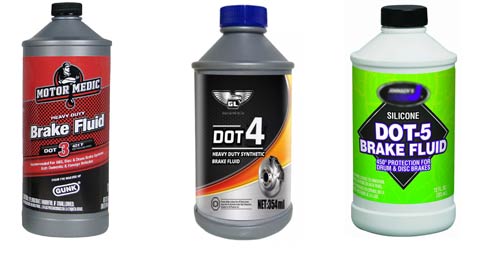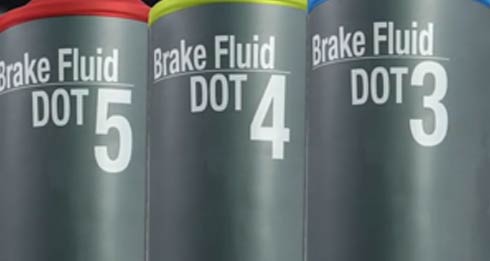When it comes to DOT 3 vs DOT 4 vs DOT 5 brake fluid, it can be hard to know which one is the best for your car.
It can be tough to decide which brake fluid is best for your car. DOT 3, DOT 4, and DOT 5 brake fluids are all designed to do different things and some are better for certain types of cars than others.
We’re here to help clear up the confusion. In this article, we’ll discuss the differences between DOT 3, DOT 4, and DOT 5 brake fluids so you can make an informed decision about which one is right for you.
What are DOT 3 Vs DOT 4 Vs DOT 5 Brake Fluid?

DOT 3 brake fluid, DOT 4 brake fluid, and DOT 5 brake fluid are all hydraulic fluids that are used to create pressure in the brake system.
While the liquids may be similar, they each have different properties which allow them to perform better under certain conditions.
DOT stands for Department of Transportation, which is the federal agency that sets the standards for the different types of brake fluid. The numbers in the names of each type of brake fluid indicate how quickly they absorb water.
The lower the number, the less water that is absorbed by the brake fluid when exposed to moisture.
DOT 3 brake fluid absorbs water slowly and is used in systems that do not get very hot or need to avoid corrosion from moisture. DOT 4 brake fluid absorbs water more quickly and is suitable for most types of cars because it contains a lubricant, which lessens wear.
DOT 5 brake fluid absorbs moisture even faster and is a good choice for high-performance racing cars that get very hot or may need to be stored in humid conditions.
The Differences between the Three Types of Brakes Fluids
Although they’re all hydraulic fluids that serve the same function, the different types of break fluid have more important properties than determining how well they work and which type of car should use each one.
DOT 3 Brake Fluid: DOT 3 contains silicone oil as a lubricant. It is compatible with rubber but not plastic seals and should never be used in ABS (antilock brake systems) or in power steering.
It is not compatible with DOT 4 and may cause seals to swell and fail when used in these systems. DOT 3 brake fluids should be replaced every two years because the lubricant will break down over time, causing the system to get hot and wear out more quickly.
DOT 4 Brake Fluid: DOT 4 brake fluid is a synthetic oil with a large amount of glycol ether. It does not contain silicone and can be used in ABS or power steering systems safely. It is compatible with all rubber seals but may not always be compatible with plastics depending on the type of plastic and how it was made. DOT 4 brake fluid should be replaced about every two years.
DOT 5 Brake Fluid: DOT 5 brake fluid is designed to resist absorption of water and resists temperatures up to 500 degrees Fahrenheit. It does not contain glycol ethers or silicone, making it suitable for vehicles that may be exposed to high heat or moisture.
Although all three types of brake fluid are safe for normal brake systems, DOT 5 is the best choice if you need to avoid exposure to extreme heat or moisture. It is important to note that DOT 5 fluid isn’t always compatible with ABS and power steering systems because it may swell some types of plastics.
Which Brake Fluid is best for Your Car?

DOT 3 brake fluid is a popular choice because it is compatible with rubber and plastic seals. This makes it more suitable for cars that get cold, such as vintage vehicles or classic muscle cars, since DOT 3 won’t break down in extreme temperatures.
If you don’t drive a car that needs DOT 5 fluid for its ABS or power steering system, then DOT 4 brake fluid is a good choice since it’s more stable than DOT 3. The following are the most important properties of each type of brake fluid:
Viscosity:
DOT 3 is the thinnest and flows best at very cold temperatures. DOT 4 is thicker and flows better at colder temperatures than DOT 5, which has a viscosity similar to water and flows easily even when very cold.
Shear stability:
DOT 3 brake fluid breaks down in heat and loses its viscosity over time. This makes it a poor choice for high-performance applications like racing. DOT 4 brake fluid is less likely to break down, but it still degrades when exposed to heat and shear (when the level of liquid changes due to heating or cooling).
Compatibility with rubber and Plastic:
DOT 3 brake fluid should not be used in ABS or power steering systems because it can damage some types of plastics. It is compatible with rubber seals, making it suitable for vintage and classic cars that may need to be serviced in cold conditions.
Chemical Structure:
DOT 4 brake fluid contains glycol ether, which is not compatible with ABS or power steering systems. It will swell the seals in these systems and may cause them to fail if used long-term.
Tips on Choosing the Best Brake Fluid for Your Car
If you drive a car that needs DOT 5 fluid for its ABS or power steering system, then you should always choose DOT 5. If your car doesn’t need these types of systems, then either DOT 3 or DOT 4 brake fluid is a good choice.
Because DOT 4 is thicker than DOT 3 and has better shear stability, it’s more suitable for high-performance applications like racing. However, DOT 5 has better chemical stability and can resist exposure to water or extreme temperatures.
You should always use the type of brake fluid recommended in your vehicle’s owner manual if you need ABS or power steering systems.
If you don’t need these types of systems, then choosing between DOT 3 and DOT 4 brake fluid is a matter of personal preference because they both work well and offer similar benefits.
It should be noted that brake fluid is only one part of the braking system. If you’re experiencing problems with noise, responsiveness, or stopping distances, then it’s best to bring your car to a trusted mechanic like one from Your Mechanic for assistance pinpointing and correcting any issues.
Conclusion
There are three types of brake fluid: DOT 3, DOT 4, and DOT 5. Each type has its own pros and cons, for instance, whereas it is compatible with rubber seals (making it suitable for vintage or classic cars), it will break down in extreme temperatures. If your car needs the ABS or power steering systems, then you should always choose DOT 5; if not, either one would be a good fit. Good luck!

